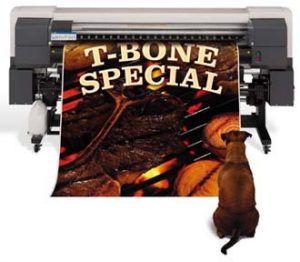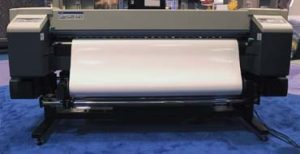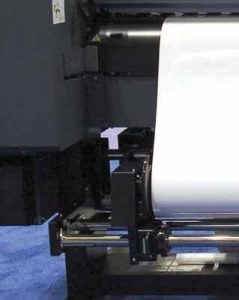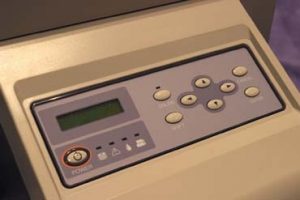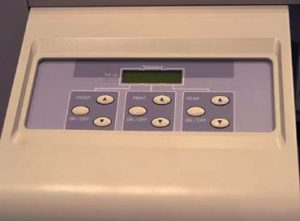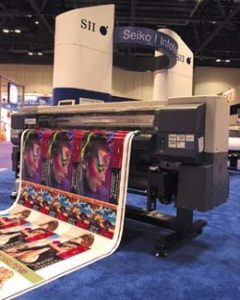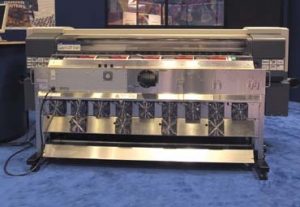Digital Printing
Seiko I Infotech Inc.’s ColorPainter 64S
Stunning output at blazing speed
Published
18 years agoon
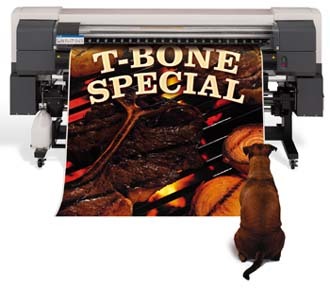
Over the past few months, we’ve reviewed numerous products that were introduced during last April’s ISA show in Orlando, FL. This month, we’re reporting on |2265|’s ColorPainter 64S. Seiko has been in the color-printing business for many years. In fact, one of us, we won’t say who, actually worked for Seiko during the 1980s.
At the show, the ColorPainter 64S produced some stunning images. According to its manufacturer, speed, quality and economics make this printer special.
Specifications and media size
The printer’s name, ColorPainter 64S, accurately describes its capabilities. The six-color, solvent inkjet (Fig. 1) accepts media up to 64 in. wide. This might not sound too remarkable. However, this printer is in a class by itself. The system measures 100 in. wide x 33.9 in. deep x 47.3 in. high and weighs 506 lbs. Its selectable power can either be 110 to 120V or 200 to 220V.
Furthermore, the unit features six industrial-quality piezo printheads that comprise 512 nozzles per color — a total of 3,072 nozzles. The printer’s resolution is a true 720 dpi.
Its media take-up and image-drying systems come standard with the printer. The take-up system, which is optically driven, allows all the prints to be stored onto a single roll. Fig. 2 indicates the take-up media path. Two control panels, located on opposite ends of the printer’s front, manage the system’s controls. One control panel (Fig. 3) handles media movement, diagnostics and printer status; another control panel sets the drying system’s operating temperatures (Fig. 4). The media heating/drying system actually covers three zones — front, print and rear.
A 5mm margin on the top, bottom, left and right edges must be considered when determining the actual printable image area. Basically, 60-in. media will yield a final printed image of 59.6 in. The printer is also rated at a 150-ft. image length, which is probably outside the RIP’s capabilities and should be more than sufficient for most applications.
A head-height adjustment allows you to work with both thick and thin media, ranging from 0.07 to 0.63mm, as well as cut-sheet pieces and media rolls.
Ink and media
We believe Seiko designed this printer from a signmaker’s perspective. Why? Well, let’s start with ink. Although solvents, ecosolvents and UV inks have answered signmakers’ outdoor-durability prayers, you sometimes sacrifice image quality for durability. In other cases, you have to print onto specific matched media, or use lamination to achieve specific durability guarantees.
Seiko has taken a different approach to this problem. The manufacturer offers one ink type and expects users to use their preferred media. The printer uses one type of ink, EG-Outdoor. "EG" stands for "expanded gamut."
A color gamut refers to a device’s color range or spectrum. If you’ve worked with any type of color printer, you know it’s difficult, or even impossible, to produce certain colors. The EG-Outdoor inks expand the gamut associated with a CMYK ink set. Fig. 5 depicts some of the vibrant colors the machine can produce.
Consequently, Seiko fine-tuned the reds and blacks. The end result? Very deep-black and bright-red colors. We noticed that the ColorPainter 64S’ print colors were well-saturated, and the machine’s 720-dpi resolution produced fine details, even up close.
Although image quality is important, outdoor durability can be even more important. An ideal outdoor print must be water- and UV-resistant, and capable of withstanding mild cleaning agents.
Seiko doesn’t advertise that its inks are eco-friendly or safe in a non-vented environment. The manufacturer has employed an aggressive solvent that helps the pigment bond to the media. The inks, however, have a lower solvent content than most traditional solvent inks. Seiko’s inks don’t produce a high level of VOCs, and they don’t contain a deadly solvent called cyclohexanon.
However, Seiko advises users to properly vent the equipment and provide an optional exhaust attachment. The company believes it’s better to produce true solvent inks, which exhibit durability characteristics, as opposed to weakening the ink so the printer can exist in an office environment.
According to the manufacturer, images printed onto adhesive vinyl or banner material will survive up to three years outdoors, with no lamination. It also claims that images can be applied to an uneven surface — installed over rivets or curved surfaces — without cracking. If an image gets dirty, the customer should clean it with a standard cleaning product.
You won’t find Seiko-specific media for the ColorPainter 64S — as a signmaker, you probably prefer certain adhesive vinyl, banner materials and other specialty media products. On its website, Seiko lists all the media types it has analyzed under typical outdoor conditions. The list comprises cast and calendered vinyl products from such manufacturers as 3M, Avery and MACtac.
The need for speed
Seiko believes the ColorPainter 64S’ draft-printing mode is seldom used and that most signmakers opt for the two best-quality modes — the 720 x 720-dpi, four-pass mode (standard) and the 720 x 720-dpi, eight-pass mode (high quality). According to Seiko, the standard mode is a good balance between photographic and solid colors; the high-quality mode is best used to print photographic images viewed from close distances.
In standard-print mode, the system operates at 176 sq. ft./hr. — more than 29, 2 x 3-ft. prints per hour. This speed is up to five times faster than some printers in the same class. In high-quality print mode, the unit operates at 88 sq. ft./hr., which is a bit faster than standard-mode printing speed. To attain this speed, the printer employs 3,072 nozzles and a high-speed, SCSI-2 interface for data input.
Problems can occur when printing at such high-speed rates. For example, if the printer is running unattended, the integral dryers may not keep up with the take-up system. Recognizing this problem, Seiko offers an optional, add-on dryer that connects to the printer’s front (Fig. 6). The dryer, which costs approximately $3,500 and requires 200 to 220V of power, can keep up with the printer and take-up system, even while printing at 176 sq. ft./hr. In addition, the timer can be set so the dryer will operate for up to 12 hours at a time, which allows the printer to operate overnight. You simply unload the prints in the morning.
What about the printer’s ink system? Recognizing that high speed is useless if it requires significant operator intervention, Seiko designed the printer to incorporate one-liter ink cartridges. In addition, each color contains a reservoir that allows printing to continue while a cartridge is being swapped. Each cartridge is keyed, so a wrong color can’t be put into a slot.
Economics
The ColorPainter 64S’ list price is $32,995 — a fair price for such a workhorse. The price includes a one-year warranty, with six months on the printheads. For an additional $1,299, you can extend the printhead warranty to a full year. After a year, the warranty costs $3,499 for an additional year on both the printer and printheads. Maintenance takes place onsite.
So, how about print costs? Surprisingly, the one-liter ink cartridges cost $299 per color — approximately 10% less than competing print systems’ ink-cartridge costs. Because you can use off-the-shelf media, print prices should be better than average.
We didn’t mention a software connection, because Seiko believes serious shops use third-party RIPs. Most major RIP manufacturers either support the ColorPainter 64S, or have committed to do so in the near future.
Seiko has proven you don’t need to invent a new technology to introduce an outstanding product. It’s obvious the manufacturer considered the market and its users prior to creating such a quality, high-production machine, whose image quality is outstanding. With very reasonable consumables prices, the ColorPainter 64S deserves your attention, especially if you’re seeking a high-quality system capable of producing outdoor-durable graphics quickly.
| Key Information |
Report Date: April 2004 Company: Seiko Instruments USA Inc. Company Background: Seiko I Infotech Inc. is a subsidiary company of Seiko Instruments USA Inc., a 67-year-old manufacturer of precision instruments and micro-electronics. Seiko Instruments USA is committed to developing and marketing color and monochrome wide-format printer systems, including LED and inkjet printers, as they have been for the last 30 years. Contact: Pat Ryan, general manager Minimum System Requirements: Third-party RIP (each manufacturer will dictate the system requirements). List Price: $32,995 |
SPONSORED VIDEO
Introducing the Sign Industry Podcast
The Sign Industry Podcast is a platform for every sign person out there — from the old-timers who bent neon and hand-lettered boats to those venturing into new technologies — we want to get their stories out for everyone to hear. Come join us and listen to stories, learn tricks or techniques, and get insights of what’s to come. We are the world’s second oldest profession. The folks who started the world’s oldest profession needed a sign.
You may like
Advertisement
Subscribe

Magazine
Get the most important news
and business ideas from Signsofthetimes Magazine.
Advertisement
Most Popular
-

 Tip Sheet1 week ago
Tip Sheet1 week agoAlways Brand Yourself and Wear Fewer Hats — Two of April’s Sign Tips
-

 Photo Gallery2 days ago
Photo Gallery2 days ago30 Snapshots of the 2024 ISA Sign Expo
-

 Ask Signs of the Times4 days ago
Ask Signs of the Times4 days agoWhy Are Signs from Canva so Overloaded and Similar?
-

 Real Deal2 weeks ago
Real Deal2 weeks agoA Woman Sign Company Owner Confronts a Sexist Wholesaler
-

 Benchmarks7 days ago
Benchmarks7 days ago6 Sports Venue Signs Deserving a Standing Ovation
-

 Women in Signs2 weeks ago
Women in Signs2 weeks ago2024 Women in Signs: Megan Bradley
-

 Photo Gallery1 week ago
Photo Gallery1 week ago21 Larry Albright Plasma Globes, Crackle Tubes and More
-

 Women in Signs1 week ago
Women in Signs1 week ago2024 Women in Signs: Ashley Borell

